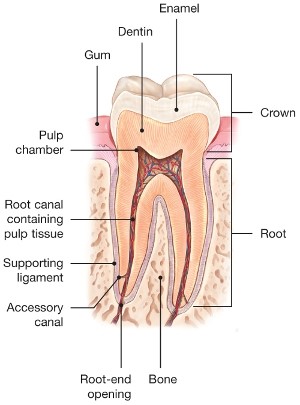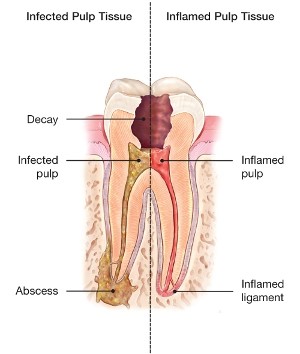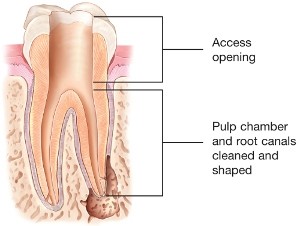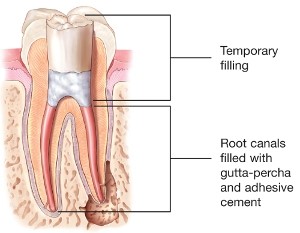Locating and properly disinfecting all the canals is what will lead to a successful outcome. An endodontist has gone through extra training, past dental school, to acquire advanced knowledge and skills needed for difficult to find or treat canals. Endodontists are trained to use advanced technologies such as operating microscopes, 3D imaging, and ultrasonic instruments. A board-certified endodontist represents an individual who has undergone 3 separate, rigorous examinations to achieve the pinnacle of their profession. This a feat that only around 20% of endodontists have achieved. Keep this in mind when selecting who will provide your endodontic care.
After properly and thoroughly cleaning and shaping the canals, they are then dried and filled to their full length. The root filling (gutta-percha) is a safe and soft material that can adapt to the shape of the canals to provide a 3-dimensional seal.
The tooth will then receive a temporary filling (restoration), which will be removed by your referring dentist who will then provide a final restoration that can range from a simple white filling, to an inlay, onlay, or crown. Your dentist will determine which type of final restoration is best for you. It is very important to go back to your dentist to receive this restoration in order to strengthen and seal the tooth, and help ensure the best possible success for your root canal treatment
Root Canal Treatment










Saving your natural tooth is an excellent decision, since nothing looks, feels, or functions like your natural tooth.


ROOT CANAL TREATMENT STEP BY STEP
Root Canal Treatment (or Endodontic Therapy) is a type of dental treatment needed when the nerve (pulp) becomes either irritated (inflamed), or infected (necrotic). The most common cause (etiology) for this is decay (caries) that reaches the pulp. Other common etiologies include cracked teeth and traumatic dental injuries. All of these etiologies allow bacteria that is common in the oral cavity to reach the pulp causing inflammation at first, followed by infection.
After thorough diagnostic testing and x-ray (radiographic) imaging are completed to ensure an endodontic problem exists, and which tooth is affected, the prognosis and description of root canal treatment will be explained to you.
Root canal treatment begins with numbing (anesthetizing) the tooth to ensure a comfortable and pain free appointment. Then a protective shield (dental dam) is placed over the offending tooth to provide isolation and maintain a clean environment. Next, an opening (access) is made through the top (crown) of tooth. At this time decay is removed, so only clean and healthy tooth tissue remains, and the canals are located.
The canal(s) are tunnels or tubes within the roots of the tooth where the pulp, which contains nerves and blood vessels, is found. The number of canals found depend on the tooth type bring treated. Typically, front (anterior) teeth have 1 or sometimes 2 canals. Back (molar) teeth have 3, 4, or sometimes even more canals. A common misconception is that root canal treatment removes the roots of the tooth. This is not true. The canals, within the roots, are treated, but the roots are left intact.
Next, the length of each canal is carefully determined. Then the canals are treated using small instruments of various sizes and fluid irrigation to meticulously disinfect, clean, and shape them.
